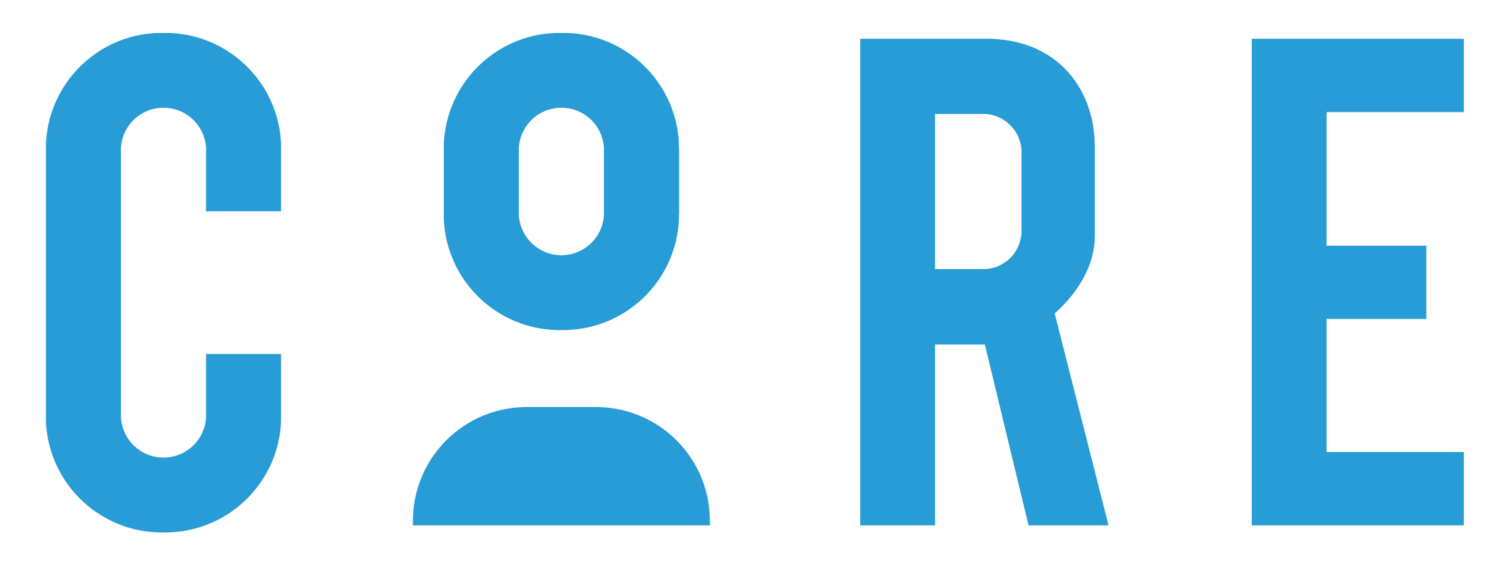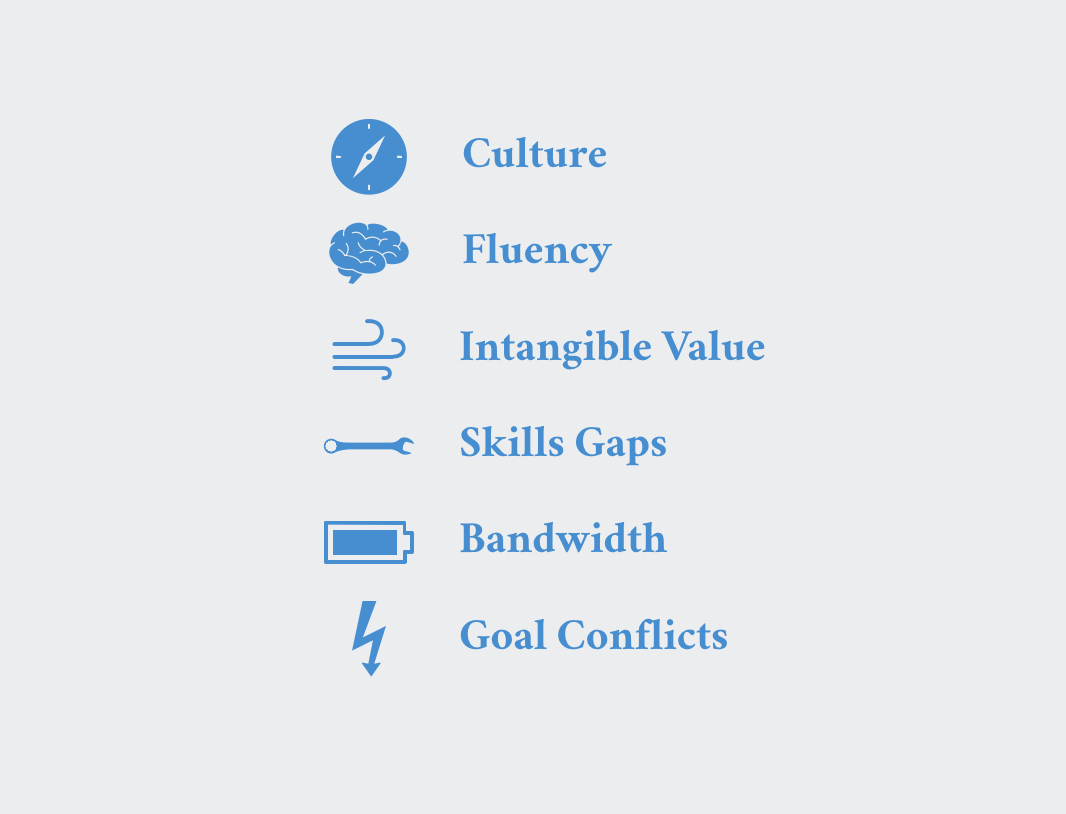Tools for Vision and Strategy
Organizations have a wealth of intelligence to draw upon.
But how do we tap into all of that knowledge without creating chaos? The best organizations have invented concrete methods of doing exactly that, and have moved a significant fraction of the "organizational brain" to the middle of the organization.
The strategies formed in a 2-day leadership offsite will probably be crushed by the strategies formed in your competitor's 3-day offsite.
But the strategy that will beat both of those every day is the strategy proposed by a non-leadership team.
Analyze and Understand
Action that happens before understanding creates mistakes.
Regardless of how logical or intellectually sound re-orging or throwing money at a problem appears to be, research shows that these efforts fail to set the company on the right trajectory anywhere from 50 - 80% of the time.
We must first analyze the true nature of the obstacles we are facing if we hope to overcome them.
The 6 Underlying Factors
Vision and strategies, whether innovative or practical, are simply the output of people, teams, and culture. Deficiencies in those areas create hurdles that are difficult or impossible to overcome.
An analysis of the 6 Underlying Factors of your organizations' heath will reveal clear and actionable factors that are creating headwinds to quality vision, strategy formation, and downstream buy-in, collaboration, and execution.
The 4 Superstar Types
Every important discussion must integrate a minimum of four perspectives: Market Empathy, Corporate Strategy, Employee Empathy, and Topic Strategy.
We can attempt to get those perspectives through research and process, but that is not how great companies go about it. What great companies understand is that there are people who naturally align to these perspectives. They do not need to be taught to do this...they don't even need to be asked.
We help you diagnose the missing perspectives and the impact it is having on the quality of your strategies. When corrected, your strategies, decisions, and long-range future improve...automatically.
Tools of Action
Roundtable
Generate vision or strategies of massive collective intelligence, and make more progress in one day than the organization would normally make in months.
Roundtable confronts a business challenge and outputs a highly-detailed strategy or vision. Roundtable can be used to create breakthrough moments in product, go to market challenges, marketing and message, customer experience, internal efficiency, culture, and brand/identity.
In addition to this concrete outcome, roundtable creates lasting, cross-departmental relationships and respect that are critical during later execution phases.
Strategy Gut Check
A fast project for immediate insight and clarity. We identify the 4 superstars in your company and get immediate feedback and insights from these perspectives.
This deliverable will detail how these perspectives revealed concrete and actionable challenges, obstacles, and pitfalls of a strategy or change initiative, with concrete steps that can be taken to address each gap.
Executive Inversion
Have you ever had your perspective shifted through travel, service, or conversations with people who expanded your mind?
This program will do exactly this for your executives, exposing them directly to operational realities through a series of conversations over a four-week period. At the end, we collect the newly-formed perspectives and deliver a concrete set of steps to instrument often dramatic and far reaching impact.
Especially valuable to overburdened executive teams who may have lost their connection to deeper parts of the organization, this highly-efficient process re-establishes connection and creates a significant impact on the teams who witness this effort.
Change Management
We help you re-examine the outdated paradigms of change management that were built in the manufacturing era. We share the techniques that have worked in the modern era of intellectual work and have propelled change in some of the most sophisticated, at-scale technology companies in the world.
Tools of Skill
For organizations ready to commit to raising the baseline of skill, we offer coaching in the supplemental components of Vision and Strategy creation we uniquely bring.
These techniques do not conflict with what you do today: you are free to keep your process and integrate these dramatically perspective-enhancing skills.
Human-Centered Design
The way we build and solve can either align to human nature or fight it. The result of building to human nature is that we multiply people's abilities. When we fight human nature, we get a fraction. If you have a team of 10 that is going slower than a team of 5, you know what this means.
Human-centered design is the process of using keen insight and empathy as a data source of what designs will improve efficiency and impact. Whether we're designing workflows, ergonomic desks, software, or even a cadence of meetings on a specific topic, there are ways of design that diminish human potential, and ways that multiply it. Expedience in design nearly always results in the former.
Decision Frameworks
Why do some decisions take a lot longer than they should (you will probably encounter that deciding whether to work with us), while others go way too fast and create unnecessary waste and chaos?
Decisions are simply the process of SEE, THINK, ACT. In each of these phases, there are superior methods of seeing, thinking, and action. Organizations deficient in any of these areas will construct flawed vision and strategies that struggle to find compatibility with either the market or their own people.
Cultures of Perspective
Organizations have many cultures, but a few are critical to establish a shared understanding of how we see, think, and act as a team.
Perspective is the phenomenon that we all require insights from people in other areas of our org to make great decisions. In fact, decisions will usually be fairly poor without those perspectives. We shift the direction of perspectives from push to pull, and this creates a dramatic change in overall collaboration culture and identification of leaders who seek maximum knowledge rather than maximum individual pride.
Problem Types
In business, there are small problems we can dispatch easily and big problems we can break apart and solve in smaller pieces.
But recently, because of technology and the wave of disruption it's brought, there's a whole new category of problem in business: complex problems. Problems we cannot solve through division...they must be solved through raw intelligence and wide collaboration and focus.
These problems are not solved in leadership offsites because there is not enough information. They are not solved in 1-hour meetings because there is not enough depth. They are not solved through program management or design sprints because the informational needs reach far beyond the capacity of these approaches.
Complex problems can only be solved one way: Roundtable.
Innovation Hierarchy
You can innovate in many ways, but only one way makes you an innovative company. Management Innovation.
Management innovation, unlike operational, product, or strategic innovation, fundamentally shifts the way the company works. You can tweak process, product, or even go-to-market strategy, but management innovation shifts talent philosophies, how we work, cultures, habits, and definitions of success.
Organizations only become permanently innovative through management innovation. When it comes to being innovative, it's not a "fake it till you make it" situation.


